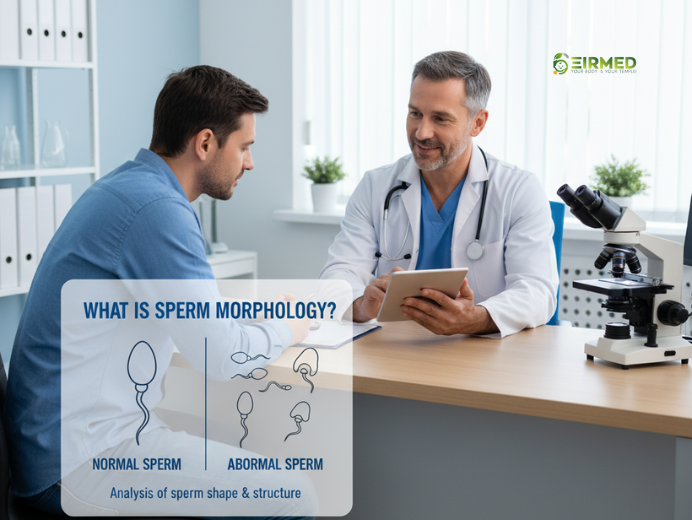What Is Sperm Morphology? Causes, Effects, and Powerful Pregnancy Tips 2025

What Is Sperm Morphology? | How to Get Pregnant with Poor Sperm Morphology
 What is sperm morphology? It refers to the shape and size of sperm cells. This aspect of male fertility reveals a great deal about how effectively sperm can reach and unite with an egg. Many people are unfamiliar with it, but understanding it can be beneficial if you are planning a family. At EIRMED, our site focuses on fertility for men and women. We offer medicines and treatments to support your needs, like supplements for better sperm health. In this guide, we will explain everything in simple words. We want you to feel informed and hopeful.
What is sperm morphology? It refers to the shape and size of sperm cells. This aspect of male fertility reveals a great deal about how effectively sperm can reach and unite with an egg. Many people are unfamiliar with it, but understanding it can be beneficial if you are planning a family. At EIRMED, our site focuses on fertility for men and women. We offer medicines and treatments to support your needs, like supplements for better sperm health. In this guide, we will explain everything in simple words. We want you to feel informed and hopeful.Understanding Sperm Morphology Basics
 Sperm morphology looks at the head, middle part, and tail of each sperm. The head holds the DNA, which is the information needed for a baby. It should be oval and smooth. The middle part gives energy for swimming. The tail helps it move forward like a whip. When we ask, ‘What is sperm morphology?’ we mean checking if these parts are formed correctly.
Sperm morphology looks at the head, middle part, and tail of each sperm. The head holds the DNA, which is the information needed for a baby. It should be oval and smooth. The middle part gives energy for swimming. The tail helps it move forward like a whip. When we ask, ‘What is sperm morphology?’ we mean checking if these parts are formed correctly.How to Get Pregnant with Poor Sperm Morphology
 How to get pregnant with poor sperm morphology? This question worries many couples trying to have a baby. Poor sperm morphology means the sperm have odd shapes. This can make it harder for them to reach and join with an egg. But do not lose hope. Many people still get pregnant even with this issue. At EIRMED, our website offers support for fertility in both men and women. We sell medicines and products like male fertility supplements to improve sperm health. In this article, we will explain what this means, why it happens, and simple ways to help. We use information from trusted sources to provide you with clear advice. You can take steps today to boost your chances.
How to get pregnant with poor sperm morphology? This question worries many couples trying to have a baby. Poor sperm morphology means the sperm have odd shapes. This can make it harder for them to reach and join with an egg. But do not lose hope. Many people still get pregnant even with this issue. At EIRMED, our website offers support for fertility in both men and women. We sell medicines and products like male fertility supplements to improve sperm health. In this article, we will explain what this means, why it happens, and simple ways to help. We use information from trusted sources to provide you with clear advice. You can take steps today to boost your chances.- Optimize Lifestyle for Better Sperm Health
- Take Fertility Supplements
- Get Regular Semen Analysis
- Address Medical Causes
- Try Intrauterine Insemination (IUI)
- Consider In Vitro Fertilization (IVF) with ICSI
- Support Each Other as a Couple
- Explore Sperm Donation as an Option
What is Sperm Morphology?
Causes of Abnormal Sperm Morphology
 What could be behind those unusual sperm shapes? Several things can lead to abnormal sperm morphology, also known as teratozoospermia. Genetics plays a role; some men inherit traits that affect the form of their sperm. Environmental factors, such as exposure to toxins like pesticides or heavy metals, can also alter sperm structure.
What could be behind those unusual sperm shapes? Several things can lead to abnormal sperm morphology, also known as teratozoospermia. Genetics plays a role; some men inherit traits that affect the form of their sperm. Environmental factors, such as exposure to toxins like pesticides or heavy metals, can also alter sperm structure.Why Sperm Morphology Matters in Fertility
How Doctors Test for Sperm Morphology
 Testing is easy and key to understanding what sperm morphology is in your case. It starts with a semen analysis. You give a sample to a lab or a home. They look under a microscope after staining the sperm.
Testing is easy and key to understanding what sperm morphology is in your case. It starts with a semen analysis. You give a sample to a lab or a home. They look under a microscope after staining the sperm.Symptoms of Poor Sperm Morphology
Common Causes of Abnormal Sperm Morphology
Sperm Morphology Percentage
Low Morphology Sperm
A normal sperm has a smooth, oval-shaped head and a single, long tail. Abnormalities can include:
- A head that is too large, too small, or misshapen.
- Two heads or two tails.
- A crooked, short, or coiled tail.
It’s important to understand that a significant portion of a man’s sperm will naturally have some morphological abnormalities. Fertility is not necessarily impaired unless the percentage of normal sperm falls below a certain threshold, often cited as 4% to 14% depending on the criteria used
2 Morphology Sperm
Ways to Improve Sperm Morphology Naturally
 Good news: You can often make sperm morphology better. Start with healthy eating. Foods rich in fruits, vegetables, nuts, and fish are beneficial. They give antioxidants to protect sperm.
Good news: You can often make sperm morphology better. Start with healthy eating. Foods rich in fruits, vegetables, nuts, and fish are beneficial. They give antioxidants to protect sperm.When to Get Help for Sperm Morphology Issues
Advanced Treatments for Poor Sperm Morphology
When dealing with sperm morphology treatment, also known as teratozoospermia, advanced treatments often focus on assisted reproductive technologies (ART) to bypass the issue and increase the chances of a successful pregnancy.1 The most common and effective of these treatments is Intracytoplasmic Sperm Injection (ICSI), which is typically performed as part of an In Vitro Fertilization (IVF) cycle. Other advanced approaches may include surgical procedures to retrieve healthier sperm.
Advanced Treatments
- Intracytoplasmic Sperm Injection (ICSI): This is the most common and effective treatment for severe teratozoospermia. During an IVF cycle, a single sperm is carefully selected, often based on its appearance and motility, and then directly injected into the cytoplasm of an egg. This process bypasses the need for the sperm to naturally fertilize the egg, overcoming the obstacle of poor morphology.
- Surgical Sperm Retrieval: In cases where there are very few or no sperm in the ejaculate, but sperm are still being produced in the testes, surgical procedures can be used to retrieve them. These retrieved sperm, even if morphologically abnormal, can then be used in an ICSI cycle. Examples of these procedures include:
- Testicular Sperm Aspiration (TESA): A needle is used to extract sperm directly from the testicle.
- Testicular Sperm Extraction (TESE): A small piece of testicular tissue is surgically removed to find and extract sperm
- Hormonal Therapy and Medical Treatments: For some men, hormonal imbalances or reproductive tract infections can contribute to poor sperm morphology. In these cases, a doctor may prescribe hormonal medications or antibiotics to treat the underlying cause. While not a direct treatment for teratozoospermia itself, addressing these issues can potentially improve overall sperm quality.
Lifestyle Changes and Supplements
While not considered “advanced treatments,” certain lifestyle changes and supplements are often recommended to improve overall sperm health and may have a positive impact on morphology. It’s important to note that it takes about three months for new sperm to be produced, so any changes made will require time to show results.
- Antioxidant Supplements: Vitamins C and E, selenium, and Coenzyme Q10 are examples of antioxidants that can help reduce oxidative stress, which is a key contributor to sperm damage and poor morphology.
- Healthy Lifestyle: A balanced diet, regular exercise, maintaining a healthy weight, and reducing stress can all positively influence sperm health.
- Avoidance of Harmful Substances: Quitting smoking and reducing alcohol and drug use can significantly improve sperm parameters, including morphology.
How to Get Pregnant with Poor Sperm Morphology
Myths About Sperm Morphology Debunked
Lifestyle Tips to Boost Overall Sperm Health
Overall Purpose
FAQs About Sperm Morphology
1. What exactly is sperm morphology?
2. Can you get pregnant with low sperm morphology?
3. What causes low sperm morphology?
- Lifestyle: Smoking, heavy alcohol use, drug use, and an unhealthy diet.
- Heat: Prolonged exposure to high temperatures (e.g., hot tubs, saunas, or tight underwear) can negatively impact sperm quality.
- Medical Conditions: A varicocele (enlarged veins in the scrotum) is a common, correctable cause. Other causes can include hormonal imbalances or genetic issues.
- Environmental Toxins: Exposure to certain chemicals, pesticides, or heavy metals can affect sperm development.
4. Can low sperm morphology cause birth defects?
5. How can I improve my sperm morphology?
- Healthy Diet: Eat foods rich in antioxidants, such as fruits, vegetables, nuts, and whole grains.
- Exercise: Regular physical activity can help maintain a healthy weight and improve hormone levels.
- Quit Bad Habits: Stop smoking, limit alcohol, and avoid recreational drugs.
- Avoid Heat: Wear loose-fitting boxers and avoid hot tubs or saunas to maintain optimal testicle temperature.
- Supplements: Some doctors may recommend supplements like zinc, selenium, or CoQ10, though their effectiveness in improving morphology is not definitively proven.
Disclaimer
Thank You

Eirmed is an informational platform dedicated to providing reliable, science-based insights on male and female fertility, reproductive health, and natural conception.
